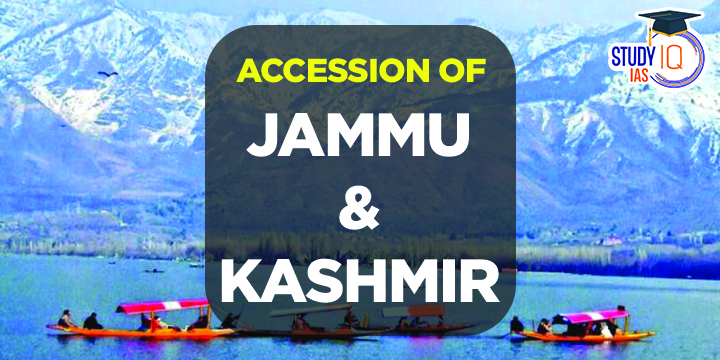Table of Contents
Accession of Jammu and Kashmir Background
- Situation before accession: After the British granted Independence to the subcontinent, independent rulers were given option of joining India, Pakistan or remaining independent.
- Maharaja Hari Singh, the ruler of the kingdom, decided to remain independent despite pressure from both India and Pakistan.
- The King was already facing challenge from Reading Room Party of 1931, an anti-Dogra group of left-wing Muslim intellectuals.
- The Muslim majority of the state found the Maharaja’s reign authoritarian.
- Standstill agreement: On August 12, 1947, J&K petitioned India and Pakistan for a standstill agreement. Pakistan signed the agreement but India refused.
- Protests: In June 1947, about 60,000 ex-army men from Poonch started a no-tax campaign against the Maharaja.
Accession of Jammu and Kashmir
- Invasion by Pakistan: Pakistan invaded Jammu & Kashmir in October 1947 through Operation Gulmarg by mobilizing tribals from the North-West Frontier Province.
- In the next two days, the invading army moved along the Jhelum River towards Baramulla, the entry point to Srinagar.
- Indian interference: Maharaja Hari Singh appealed to India for military aid to flush out the raiders. India agreed for the aid after signing of the Instrument of Accession on October 26.
- Post accession of J&K:
- Indian jurisdiction: The Instrument of Accession allowed the extension of Indian Jurisdiction to external affairs, communications and defence.
- Government: An interim popular government was formed in the state with Sheikh Mohammed Abdullah as the Prime Minister.
- Delhi Agreement: The Prime Ministers of India and Jammu & Kashmir signed the Delhi Agreement in 1952, giving special status to the state of Jammu & Kashmir under Indian constitution.
- Special provisions: Article 370 and Article 35A were added into the Indian constitution to give special status to the state of J&K.
Dogra Rule in Jammu and Kashmir
- The princely state of J&K was brought under British rule in 1846 via the Treaty of Amritsar, signed between the East India Company and Maharaja Gulab Singh, the founder of the royal Dogra dynasty.
- The ruler paid 7.5 million Nanakshahi rupees and bought the Kashmir Valley and the Ladakh Wizarat (comprising Baltistan, Kargil and Leh), and added it to his existing Jammu territory.
Accession of Jammu and Kashmir Special Provisions
Article 370:
- Features: Article 370 of the Indian constitution gave the state of Jammu & Kashmir the power to have a separate constitution, a state flag, and autonomy of internal administration.
- The article was added to Part XXI of the Indian constitution titled “Temporary, Transitional and Special Provisions”.
- Powers: It stated that the Constituent Assembly of Jammu and Kashmir would have powers to recommend the extent to which the Indian constitution would apply to the state.
- The Constituent Assembly of Jammu and Kashmir had the powers to abrogate the Article 370 altogether.
- Abrogation: On 5 August 2019, the Government of India issued a Presidential Order to supersede the 1954 order, making all the provisions of the Indian constitution applicable to Jammu and Kashmir.
Article 35 (A):
- Features: Article 35A of Indian constitution gave powers to the state of Jammu & Kashmir to define “permanent residents” of the state and provide special rights and privileges to them.
- Privileges to permanent residents included the ability to purchase land and immovable property, ability to vote and contest elections, seeking government employment and availing other state benefits such as higher education and health care.
- Discriminatory nature: The provisions of this article were considered discriminatory against immigrant workers, refugees from West Pakistan, and the State’s own female residents, who could lose their permanent resident status if they married outsiders.
- Abrogation: On 5 August 2019, the President of India issued a new Presidential Order to ensure that all provisions of the Indian Constitution applied to the State without any special provisions.


 SSC CGL Exam 2025 Apply Online Starts Ap...
SSC CGL Exam 2025 Apply Online Starts Ap...
 Daily Quiz 19 April 2025
Daily Quiz 19 April 2025
 Vehicle-to-Grid (V2G) Technology and its...
Vehicle-to-Grid (V2G) Technology and its...





















